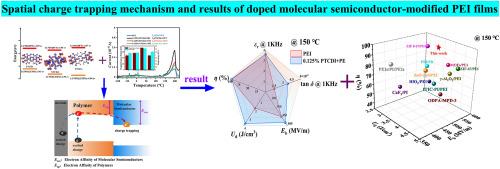聚醚酰亚胺掺杂分子半导体全有机复合材料提高介电和储能性能
IF 9.8
1区 材料科学
Q1 MATERIALS SCIENCE, COMPOSITES
引用次数: 0
摘要
聚醚酰亚胺(PEI)作为一种高温电介质,在热电耦合场下仍然面临着电流泄漏的问题,导致储能性能急剧下降。本研究以4,4′-(4,4′-异丙基二苯氧基)双邻苯酐(BPADA)和2,2-双[4-(4-氨基苯氧基)苯基]丙烷(BAPP)为原料合成了具有优异综合性能的本征PEI。通过分子设计,通过σ-π超共轭效应引入了“电子门”机制,有效抑制了远距离电荷离域。在150°C下,本构PEI的储能密度(Ud)达到1.93 J/cm3,比商用Ultem™PEI膜(1.6 J/cm3)高20.6%。通过掺杂3种分子半导体:3,4,9,10-苝四羧基二亚胺(PTCDI)、1,4,5,8-萘四羧基二酐(NTCDA)和3,4,9,10-苝四羧基二酐(PTCDA)进行进一步修饰。密度泛函理论(DFT)模拟和低能逆光电发射光谱(LEIPS)实验表明,这三种半导体都表现出比本征PEI更高的电子亲和力。此外,热激发去极化电流(TSDC)表明,与本质PEI相比,分子半导体的掺入增加了捕获电荷和捕获能级。实验和模拟结果一致表明,分子半导体掺杂可以通过在PEI矩阵内构建深阱位来提高储能性能。实验结果表明,在150°C下,掺0.125% ptcdi的PEI击穿强度为545 MV/m, Ud为3.71 J/cm3,充放电效率(η)为90.13%(本质PEI为436 MV/m, 1.93 J/cm3, 94.67%)。该研究为提高热电耦合条件下聚合物电介质的电容性能提供了一种有效的策略。本文章由计算机程序翻译,如有差异,请以英文原文为准。

Enhanced dielectric and energy storage performance of polyetherimide doping with molecular semiconductor all-organic composites
Polyetherimide (PEI), as a kind of high-temperature dielectrics, still face the issue of current leakage under thermo-electrical coupling fields, leading to a sharp degradation of energy storage performance. In this study, an intrinsic PEI with superior comprehensive properties was synthesized using 4,4'-(4,4′-isopropylidenediphenoxy)bis(phthalic anhydride) (BPADA) and 2,2-bis[4-(4-aminophenoxy)phenyl] propane (BAPP). Through molecular design, an "electron gate" mechanism was introduced via σ-π hyperconjugation effects, effectively suppressing long-range charge delocalization. The resulting intrinsic PEI achieves an energy storage density (Ud) of 1.93 J/cm3 at 150 °C, which is 20.6 % higher than that of commercial Ultem™ PEI film (1.6 J/cm3). Further modification was conducted by doping with three molecular semiconductors: 3,4,9,10-perylenetetracarboxylic diimide (PTCDI), 1,4,5,8-naphthalenetetracarboxylic dianhydride (NTCDA), and 3,4,9,10-perylenetetracarboxylic dianhydride (PTCDA). Density Functional Theory (DFT) simulations and Low-Energy Inverse Photoemission Spectroscopy (LEIPS) experiments reveal that all three semiconductors exhibit higher electron affinity than the intrinsic PEI. Additionally, Thermally Stimulated Depolarization Current (TSDC) reveals that the incorporation of molecular semiconductors increases trapped charges and trap energy level compared to intrinsic PEI. Both experimental and simulation results consistently demonstrate that molecular semiconductor doping can enhance energy storage performance by constructing deep trap sites within the PEI matrix. Experimental results demonstrate that at 150 °C, the 0.125 % PTCDI-doped PEI achieves a breakdown strength of 545 MV/m, an Ud of 3.71 J/cm3, and a charge-discharge efficiency (η) of 90.13 % (vs. 436 MV/m, 1.93 J/cm3, and 94.67 % for intrinsic PEI). This research provides an effective strategy for improving the capacitive performance of polymer dielectrics under thermo-electrical coupling conditions.
求助全文
通过发布文献求助,成功后即可免费获取论文全文。
去求助
来源期刊

Composites Science and Technology
工程技术-材料科学:复合
CiteScore
16.20
自引率
9.90%
发文量
611
审稿时长
33 days
期刊介绍:
Composites Science and Technology publishes refereed original articles on the fundamental and applied science of engineering composites. The focus of this journal is on polymeric matrix composites with reinforcements/fillers ranging from nano- to macro-scale. CSTE encourages manuscripts reporting unique, innovative contributions to the physics, chemistry, materials science and applied mechanics aspects of advanced composites.
Besides traditional fiber reinforced composites, novel composites with significant potential for engineering applications are encouraged.
 求助内容:
求助内容: 应助结果提醒方式:
应助结果提醒方式:


